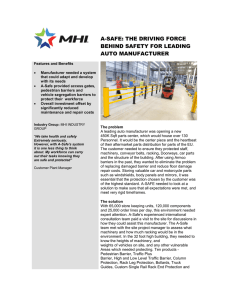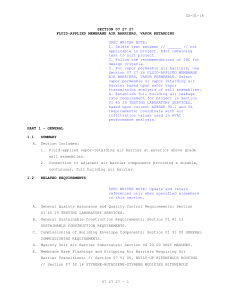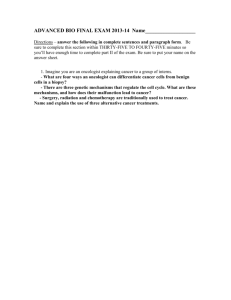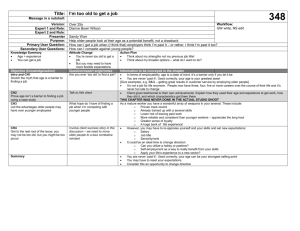02-01-16 SECTION 07 27 26 FLUID-APPLIED MEMBRANE AIR BARRIERS, VAPOR PERMEABLE
advertisement
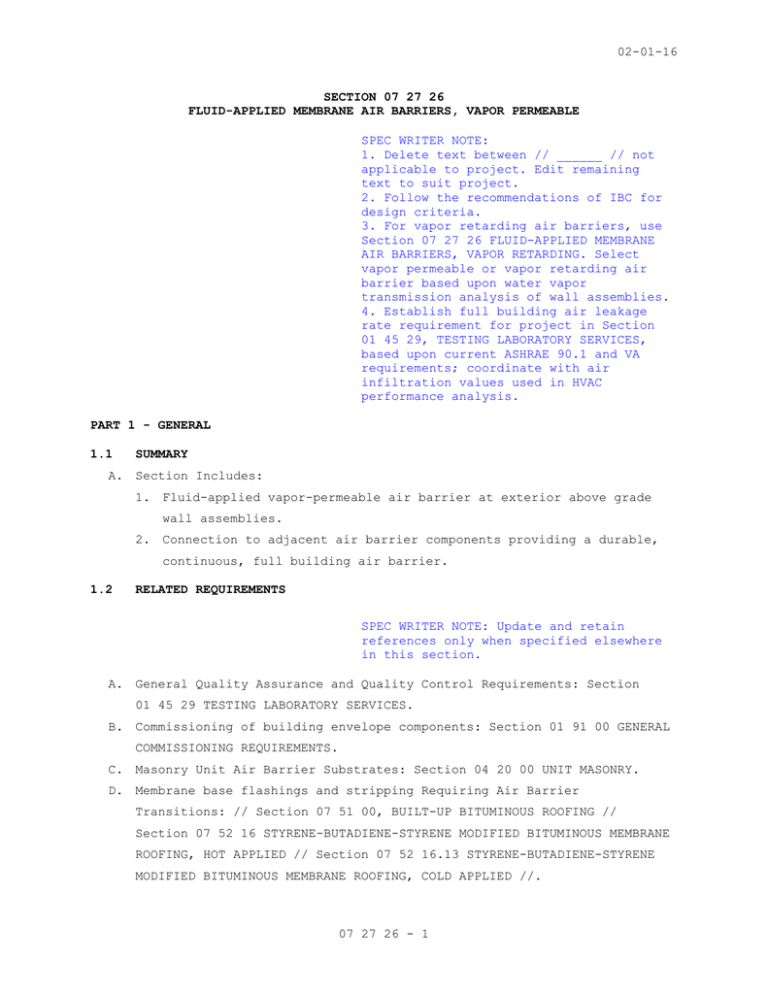
02-01-16 SECTION 07 27 26 FLUID-APPLIED MEMBRANE AIR BARRIERS, VAPOR PERMEABLE SPEC WRITER NOTE: 1. Delete text between // ______ // not applicable to project. Edit remaining text to suit project. 2. Follow the recommendations of IBC for design criteria. 3. For vapor retarding air barriers, use Section 07 27 26 FLUID-APPLIED MEMBRANE AIR BARRIERS, VAPOR RETARDING. Select vapor permeable or vapor retarding air barrier based upon water vapor transmission analysis of wall assemblies. 4. Establish full building air leakage rate requirement for project in Section 01 45 29, TESTING LABORATORY SERVICES, based upon current ASHRAE 90.1 and VA requirements; coordinate with air infiltration values used in HVAC performance analysis. PART 1 - GENERAL 1.1 SUMMARY A. Section Includes: 1. Fluid-applied vapor-permeable air barrier at exterior above grade wall assemblies. 2. Connection to adjacent air barrier components providing a durable, continuous, full building air barrier. 1.2 RELATED REQUIREMENTS SPEC WRITER NOTE: Update and retain references only when specified elsewhere in this section. A. General Quality Assurance and Quality Control Requirements: Section 01 45 29 TESTING LABORATORY SERVICES. B. Commissioning of building envelope components: Section 01 91 00 GENERAL COMMISSIONING REQUIREMENTS. C. Masonry Unit Air Barrier Substrates: Section 04 20 00 UNIT MASONRY. D. Membrane base flashings and stripping Requiring Air Barrier Transitions: // Section 07 51 00, BUILT-UP BITUMINOUS ROOFING // Section 07 52 16 STYRENE-BUTADIENE-STYRENE MODIFIED BITUMINOUS MEMBRANE ROOFING, HOT APPLIED // Section 07 52 16.13 STYRENE-BUTADIENE-STYRENE MODIFIED BITUMINOUS MEMBRANE ROOFING, COLD APPLIED //. 07 27 26 - 1 02-01-16 E. Flashing Components of Factory Finished Roofing and Wall Systems Requiring Air Barrier Transitions: Section 07 40 00 ROOFING AND SIDING PANELS. F. Metal Flashing Requiring Air Barrier Transitions: Section 07 60 00 FLASHING AND SHEET METAL. G. Joint Sealants: Section 07 92 00, JOINT SEALANTS. SPEC WRITER NOTE: Complete specifications references to suit project. H. Exterior Wall Openings Requiring Air Barrier Transitions: Division 08 sections for // aluminum-framed entrances and storefronts // aluminum windows // glazed aluminum curtain walls // louvers and vents //. I. Wall Sheathings Air Barrier Substrates: Section 09 29 00 GYPSUM BOARD. 1.3 APPLICABLE PUBLICATIONS A. Comply with references to extent specified in this section. B. Air Barrier Association of America (ABAA): 1. Quality Assurance Program. C. ASTM International (ASTM): 1. C920-14a - Elastomeric Joint Sealants. 2. C1193-13 - Use of Joint Sealants. 3. D412-06a(2013) - Vulcanized Rubber and Thermoplastic Elastomers-Tension. 4. E96/E96M-15 - Water Vapor Transmission of Materials. 5. E162-15a - Surface Flammability of Materials Using a Radiant Heat Energy Source. 6. E783-02(2010) - Field Measurement of Air Leakage Through Installed Exterior Windows and Doors. 7. E1186-03(2009) - Air Leakage Site Detection in Building Envelopes and Air Barrier Systems. 8. E2178-13 - Air Permeance of Building Materials. 9. E2357-11 - Determining Air Leakage of Air Barrier Assemblies. 1.4 SUBMITTALS A. Submittal Procedures: Section 01 33 23, SHOP DRAWINGS, PRODUCT DATA, AND SAMPLES. 1. Show size, configuration, and fabrication and installation details. B. Manufacturer's Literature and Data: 1. Description of each product. 2. Installation instructions. 07 27 26 - 2 02-01-16 C. Sustainable Construction Submittals: SPEC WRITER NOTE: Retain sustainable construction submittals appropriate to product. 1. Low Pollutant-Emitting Materials: a. Identify volatile organic compound types and quantities. D. Test reports: 1. Submit field inspection and test reports. E. Certificates: Certify each product complies with specifications. 1. Compatibility: Certify products are compatible with adjacent materials. F. Qualifications: Substantiate qualifications comply with specifications. 1. Manufacturer // with project experience list //. 2. Installer // with project experience list //. a. Include personnel qualifications. b. Field supervisor qualifications. c. Certify installer approval by air barrier manufacturer. SPEC WRITER NOTE: Retain Installation Audit paragraph below if retaining requirement for ABAA certification of Project. G. Installation Audit: 1. Submit audit report. 1.5 QUALITY ASSURANCE A. Coordinate work with adjacent and related work to provide continuous, unbroken, durable air barrier system. B. Manufacturer Qualifications: 1. Regularly and presently manufactures specified products. 2. Manufactured specified products with satisfactory service on five similar installations for minimum five years. SPEC WRITER NOTE: Retain Accreditation subparagraph below if ABAA certification is part of Project requirements. Note that requirement for ABAA certification may improve overall quality confidence and will reduce the number of potential installers, impact work result assignment among the trades, and add cost for ABAA-certified auditing of Project. 07 27 26 - 3 02-01-16 Specifier should review ABAA Quality Assurance Program Manual and coordinate air barrier and transition requirements in this and other affected sections. 3. Accreditation by ABAA. C. Installer Qualifications: 1. Regularly and presently installs specified products. 2. Approved by manufacturer. SPEC WRITER NOTE: Retain ABAA subparagraphs below if retaining requirement for ABAA certification of Project. 3. Accredited by ABAA. 4. Applicators certified according to ABAA Quality Assurance Program. SPEC WRITER NOTE: Retain two subparagraphs below for all Projects. 5. Applicators trained and certified by manufacturer of air barrier system. 6. Full time on-site field supervisor has completed three projects of similar scope within last year. SPEC WRITER NOTE: Delete Certification subparagraph below if retaining requirement for ABAA certification of Project. 7. Field Supervisor: Holds Sealant, Waterproofing, and Restoration Institute (SWRI) Wall Coating Validation Program Certificate, or similar qualification acceptable to Contracting Officer’s Representative. SPEC WRITER NOTE: Retain Accreditation subparagraph below if retaining requirement for ABAA certification of Project. 8. Field supervisor accredited by ABAA as Level 3 Accredited Installer. 07 27 26 - 4 02-01-16 SPEC WRITER NOTE: Refer to requirements and notes in Section 01 45 29 TESTING LABORATORY SERVICES. Retain paragraph below if Contractor is responsible for retaining testing agency. D. Testing Agency Qualifications: 1. Accredited by International Accreditation Service, Inc. or American Association for Laboratory Accreditation. SPEC WRITER NOTE: Retain Accreditation subparagraph below if retaining requirement for ABAA certification of Project. 2. Certified to perform ABAA Quality Assurance Program installer audits. 3. Staff experienced in installation of specified system and qualified to perform observation and inspection specified and determine compliance with project requirements. 1.6 DELIVERY A. Deliver products in manufacturer's original sealed packaging. B. Mark packaging, legibly. Indicate manufacturer's name or brand, type, production run number, and manufacture date. C. Before installation, return or dispose of products within distorted, damaged, or opened packaging. 1.7 STORAGE AND HANDLING A. Store products indoors in dry, weathertight, conditioned facility. B. Protect products from damage during handling and construction operations. 1.8 FIELD CONDITIONS A. Environment: 1. Work Area Ambient Temperature Range: 4 to 32 degrees C (40 to 90 degrees F) continuously, beginning 48 hours before installation. 2. Surface Requirements: visibly dry, and complying with manufacturer's instructions. 07 27 26 - 5 02-01-16 1.9 WARRANTY SPEC WRITER NOTE: Always retain construction warranty. FAR includes Contractor's one year labor and material warranty. A. Construction Warranty: FAR clause 52.246-21, "Warranty of Construction." PART 2 - PRODUCTS 2.1 SYSTEM PERFORMANCE A. Air-Barrier Assembly Air Leakage: Maximum 0.2 L/s/sq. m (0.04 cfm/sq. ft.) of surface area at 75 Pa (1.57 psf) differential pressure when tested according to ASTM E2357. SPEC WRITER NOTE: Retain Full Building Air Leakage Paragraph below if construction documents stipulate full building testing. B. Full Building Air Leakage: Refer to Section 01 45 29 TESTING LABORATORY SERVICES. C. Provide full system of compatible materials under conditions of service and application required. Compatibility based on testing by material manufacturer. D. Perform as continuous vapor permeable air barrier and moisture drainage plane. E. Transition to adjacent flashings and discharge water to building exterior. F. Accommodate substrate movement and seal expansion and control joints, construction material transitions, opening transitions, penetrations, and perimeter conditions without moisture deterioration and air leakage exceeding performance requirements. 2.2 PRODUCTS - GENERAL A. Provide air barrier system components from one manufacturer. B. Sustainable Construction Requirements: 07 27 26 - 6 02-01-16 SPEC WRITER NOTE: 1. Section 01 81 13, SUSTAINABLE CONSTRUCTION REQUIREMENTS includes comprehensive product list setting VOC limits for low-emitting materials. 2. Retain subparagraphs applicable to products specified in this section. 1. Low Pollutant-Emitting Materials: Comply with VOC limits specified in Section 01 81 13, SUSTAINABLE CONSTRUCTION REQUIREMENTS for the following products: a. Non-Flooring Adhesives and Sealants. 2.3 AIR BARRIER A. Fluid-Applied, Vapor-Permeable Membrane Air Barrier: 1. Elastomeric, modified bituminous or synthetic polymer membrane. 2. Air Permeance: ASTM E2178: 0.2 L/s/sq. m (0.04 cfm/sq. ft.) of surface area at 75 Pa (1.57 psf) differential pressure. 3. Vapor Permeance: ASTM E96/E96M: Minimum 580 ng/Pa/s/sq. m (10 perms). 4. Elongation: Ultimate, ASTM D412, Die C: 200 percent, minimum. 5. Thickness: Minimum 1.0 mm (40 mils) dry film thickness, applied in single continuous coat. 6. Surface Burning Characteristics: When tested according to ASTM E84. a. Flame Spread Rating: 25 maximum. b. Smoke Developed Rating: 450 maximum. 2.4 ACCESSORIES A. Primer: Waterborne primer complying with VOC requirements, recommended air barrier manufacturer to suit application. B. Counterflashing Sheet: Modified bituminous, minimum 1.0 mm (40 mils) thick, self-adhering composite sheet consisting of minimum 0.8 mm (33 mils) of rubberized asphalt laminated to polyethylene film. C. Substrate Patching Material: Manufacturer's standard trowel-grade filler material. D. Sprayed Polyurethane Foam Sealant: Foamed-in-place, 24 to 32 kg/cu. m (1.5 to 2.0 pcf) density, with maximum flame-spread index of 25 when tested according to ASTM E84. 07 27 26 - 7 02-01-16 SPEC WRITER NOTE: Include item below if not addressed in each applicable Division 08 opening section. Coordinate with application requirement in Part 3. E. Flexible Opening Transition: Cured low-modulus silicone extrusion with reinforcing ribs, sized to fit opening widths, designed for adhesion to or insertion into aluminum framing extrusions, and compatible with air barrier system materials and accessories. F. Joint Sealant: ASTM C920, single-component, neutral-curing silicone; Class 100/50 (low modulus), Grade NS, Use NT related to exposure, approved by membrane air barrier manufacturer for adhesion and compatibility with membrane air barrier and accessories. PART 3 - EXECUTION 3.1 PREPARATION A. Examine and verify substrate suitability for product installation. B. Protect existing construction and completed work from damage. C. Correct substrate deficiencies: 1. Remove projections and excess materials and fill voids with substrate patching material. 2. Remove contaminants capable of affecting subsequently installed product's performance. D. Prepare and treat substrate joints and cracks according to ASTM C1193 and membrane air barrier manufacturer's instructions. 3.2 INSTALLATION - AIR BARRIER A. Install products according to manufacturer's instructions // and approved submittal drawings //. 1. When manufacturer's instructions deviate from specifications, submit proposed resolution for Contracting Officer's Representative consideration. SPEC WRITER NOTE: Retain ABAA Paragraph below if retaining requirement for ABAA certification of Project. B. Install air barrier components according to requirements of ABAA Quality Assurance Program. C. Apply primer. D. Install transition strips and accessory materials. E. Seal air barrier to adjacent components of building air barrier system. 07 27 26 - 8 02-01-16 SPEC WRITER NOTE: Include item below if not addressed in each applicable Division 08 opening section. Coordinate with product requirement in Part 2. F. Install flexible opening transition at each opening perimeter. Extend transition onto each substrate minimum 75 mm (3 inches). 1. Fill gaps at perimeter of openings with foam sealant. G. At penetrations, seal transition strips around penetrating objects with termination mastic. 1. Fill gaps at perimeter of penetrations with sprayed polyurethane foam sealant. H. At top of through-wall flashings, seal with continuous transition strip of manufacturer's recommended material to suit application. I. Apply air barrier in full contact with substrate to produce continuous seal with transitions. J. Apply fluid membrane in thickness recommended by manufacturer, and minimum specified thickness. K. Leave air barrier exposed until tested and inspected and approved by Contracting Officer’s Representative. 3.3 FIELD QUALITY CONTROL SPEC WRITER NOTE: Section 01 45 29, TESTING LABORATORY SERVICES includes VA provided testing for large projects and contractor provided testing for small projects. Coordinate testing responsibility. A. Field Inspections and Tests: Performed by testing laboratory specified in Section 01 45 29, TESTING LABORATORY SERVICES. 1. Perform inspections and tests before concealing air barrier with subsequent work. B. Inspections: 1. Compatibility of materials within air barrier system and adjacent materials. 2. Suitability of substrate and support for air barrier. 3. Suitability of conditions under which air barrier is applied. 4. Adequacy of substrate priming. 5. Application and treatment of joints and edges of transition strips, flexible opening transitions, and accessory materials. 07 27 26 - 9 02-01-16 6. Continuity and gap-free installation of air barrier, transition strips, and accessory materials. SPEC WRITER NOTE: Retain the Testing paragraph below when project scope or complexity warrants. Coordinate with building testing requirements of Section 01 45 29 TESTING LABORATORY SERVICES and Section 01 91 00 GENERAL COMMISSIONING REQUIREMENTS if utilized for project. C. Tests: 1. Qualitative air-leakage testing according to ASTM E1186. 2. Quantitative air-leakage testing according to ASTM E783. D. Inspection and Test Frequency: Determined by installed air barrier surface area. 1. Up to 900 sq. m (10,000 sq. ft.): One inspection. 2. 901 - 3,300 sq. m (10,001 - 35,000 sq. ft.): Two inspections. 3. 3,300 - 7,000 sq. m (35,001 - 75,000 sq. ft.): Three inspections. 4. 7,001 - 11,600 sq. m (75,001 - 125,000 sq. ft.): Four inspections. 5. 11,601 - 19,000 sq. m (125,001 - 200,000 sq. ft.): Five inspections. 6. Over 19,000 sq. m (200,000 sq. ft.): Six inspections. E. Submit inspection and test reports to Contracting Officer’s Representative within seven calendar days of completing inspection and test. SPEC WRITER NOTE: Retain Audit paragraph below if retaining requirement for ABAA certification of Project. F. Audit: 1. Provide installer and site inspections audit by ABAA. 2. Coordinate scheduling of work and associated audit inspections. 3. Cooperate with ABAA’s testing agency. Allow access to work and staging areas. 4. Notify ABAA in writing of schedule for Work of this Section to allow sufficient time for testing and inspection. G. Defective Work: 1. Correct deficiencies, make necessary repairs, and retest as required to demonstrate compliance with specified requirements. 3.4 CLEANING A. Remove masking materials. 07 27 26 - 10 02-01-16 B. Clean spills and overspray using cleaning agents recommended by manufacturers of affected construction. 3.5 PROTECTION A. Protect air barrier from construction operations. B. Protect air barrier from exposure to UV light exposure exceeding manufacturer's recommendation. C. Replace overexposed materials and retest. - - E N D - - 07 27 26 - 11




